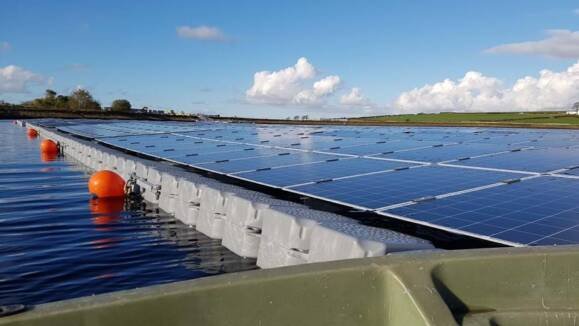Floating solar photovoltaic panels could supply all the electricity needs of some countries, new research has shown.
The study, by researchers from Lancaster and Bangor Universities and the UK Centre for Ecology & Hydrology, aimed to calculate the global potential for deploying low-carbon floating solar arrays. The researchers calculated the daily electrical output for floating photovoltaics (FPV) on nearly 68,000 lakes and reservoirs around the world, using available climate data for each location.
The researchers’ calculations included lakes and reservoirs where floating solar technology is most likely to be installed. They were no more than 10km from a population centre, not in a protected area, didn’t dry up and didn’t freeze for more than six months each year. The researchers calculated output based on FPV covering just 10% of their surface area, up to a maximum of 30 km2.
While output fluctuated depending on altitude, latitude and season, the potential annual electricity generation from FPV on these lakes was 1302 terawatt hours (TWh), around four times the total annual electricity demand of the UK.
The findings are published today [4 June 2024] in Nature Water.
FPV have a number of additional advantages over land-based solar installations: they free up land for other uses and they keeps panels cooler, making them more efficient.
There is some evidence for other environmental benefits, including reducing water loss through evaporation, by sheltering the lake surface from the sun and wind; and reducing algal blooms by limiting light and preventing nutrient circulation. However, the researchers warn that further research is needed on the overall environmental impact of FPV. They suggest that decisions to deploy FPV should consider the intended function of water bodies and how they are used, as well as the potential ecological impact.
Professor Alona Armstrong of Lancaster University, co-author of the study, said: “Our work shows there is much potential for FPV around the world. But deployments need to be strategic, considering the consequences for energy security, nature and society, as well as Net Zero.”
Lead author of the paper, Dr Iestyn Woolway of Bangor University said: “We still don’t know exactly how floating panels might affect the ecosystem within a natural lake, in different conditions and locations. But the potential gain in energy generation from FPV is clear, so we need to put that research in place so this technology can be safely adopted. We chose 10% of a lake’s surface area as a likely safe level of deployment, but that might need to be reduced in some situations, or could be higher in others.”
When the figures were considered country-by-country, five nations could meet their entire electricity needs from FPV, including Papua New Guinea, Ethiopia and Rwanda. Others, such as Bolivia and Tonga, would come very close, respectively meeting 87% and 92% of electricity demand.
Many countries, mainly from Africa, the Caribbean, South America and Central Asia, could meet between 40% and 70% of their annual electricity demand through FPV. In Europe, Finland could meet 17% of its electricity demand from FPV and Denmark, 7%.
The UK could produce 2.7 TWh of electricity each year from FPV, the researchers found. While this is just under 1% of overall electricity demand, it would provide electricity for around one million homes, based on the current Ofgem estimate of average electricity usage per household of 2,700 kWh.
There are currently very few FPV installations in the UK, with the largest a 6.3MW floating solar farm on the Queen Elizabeth II reservoir, near London.
Dr Woolway said: “Even with the criteria we set to create a realistic scenario for deployment of FPV, there are benefits across the board, mainly in lower income countries with high levels of sunshine, but also in Northern European countries as well. The criteria we chose were based on obvious exclusions, such as lakes in protected areas, but also on what might reduce the cost and risks of deployment.”
Dr Stephen Thackeray of UK Centre for Ecology & Hydrology and co-author of the paper said: “This study provides an essential global perspective on the great potential for floating solar photovoltaics to meet a significant proportion of our energy demand, as part of a transition to renewable energy sources.
“While being a key element of our transition towards clean energy, the installation of such technologies on water bodies could have ecological impacts. We advocate for close collaboration among energy and environment researchers, engineers and manufacturers so that any potential impacts are factored in during the design of future deployments, so that we can both maximise the potential of these technologies and safeguard against impacts on water quality and biodiversity.”
The research is funded by the Natural Environment Research Council, part of UK Research and Innovation.
Share your industry press now!
Are you a PR agency or sustainability-focused organization? Join the World of Renewables network FREE today and gain exclusive access to our platform to promote your business, share the latest industry news, and connect with a global audience of 700,000+ renewable energy professionals.
Register Now to start posting your updates and showcase your expertise to a highly engaged, environmentally-conscious community.
Find out more about our Content Partnership Programs.*2024 AWARD WINNER* Websites & Mobile Sites, Webby Winner, Peoples Voice 2024
